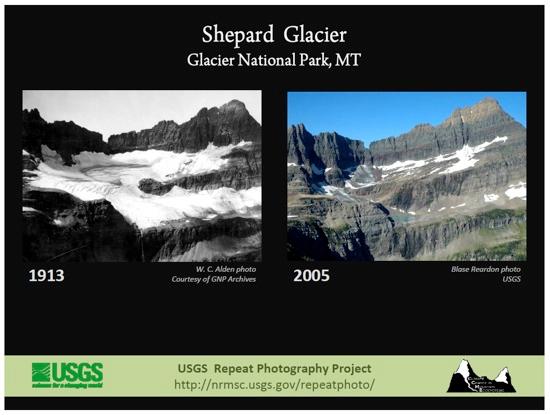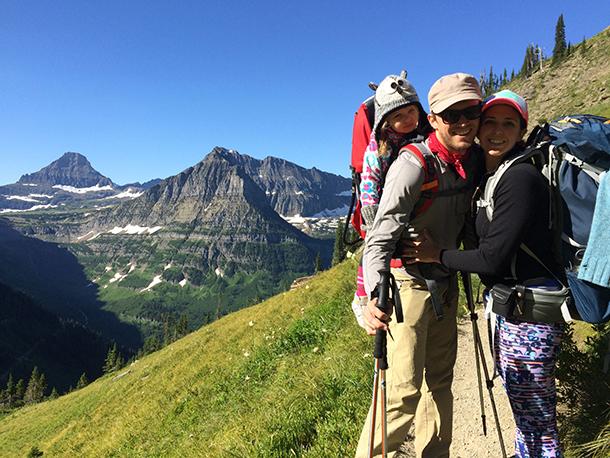A writer moves to Montana to hike, ski, and to watch the glaciers disappear
Bjorn, Amanda and Freya Beer are pictured here along the scenic Highline Trail in Glacier National Park.
Last summer, I stood with my wife on the edge of a sheer cliff in Glacier National Park. We stared down toward the massive Grinnell Glacier. In that moment, we decided to move to Montana.
I can work anywhere with internet, and my wife had multiple job offers at hospitals across the country. We could have picked anywhere, but we decided to make this remote region our home, the center of our universe.
As a writer, I’m surprised that I can’t find the exact words to explain why we chose to live in the Flathead Valley. Perhaps it’s the fact we’ll be on the largest freshwater lake west of the Mississippi, a definite advantage as the West becomes hotter and drier. Or maybe the proximity to the raw, jagged beauty of Glacier National Park lifts my soul. Perhaps we were just drawn to the great skiing, hoping our daughter can one day experience this privileged pastime, as the autumn lingers longer, and spring accelerates bit by bit, year by year.
I can’t tell you one rational reason why we chose Montana, so perhaps the rationale lies deeper — in emotion, in loss. By the year 2030, all of these glaciers will be gone. Blackfoot, Jackson, Sperry, Swiftcurrent, Grinnell and dozens more. Their stately names will disappear as they melt and flow into the sea.

Perhaps there is some guilt here, like the way we might not see a relative for years, but once she is on her deathbed, we feel compelled to visit, to commune, to see her before she loses her earthly form.
I want to be there as the glaciers melt. I want to hike to Grinnell Glacier with my then-teenage daughter in the year 2030, as the last sliver of ice sublimates into human memory. I will want to say, “I’m sorry.” I will want to say, “We tried.”
We were here last summer on a job interview my wife had at the hospital. She was looking for jobs around the country, and we went up into the park on an epic hike called the Highline Trail. It starts off at a high pass, and we ended by hiking up to a ridge that overlooked this glacier — and it was just a tremendous experience.
Climbing up this scree field — a bunch of small stones that are a little hard to get footing on — up a steep, steep trail, you climb and climb for about 45 minutes, and the view on the other side surprises you. You’re not expecting it. But you can see Grinnell Glacier a couple of thousand feet below you, and it just takes your breath away. It's this glacier that is calving off into Grinnell Lake.
The water is a very bright, bright blue — an amazing turquoise that provides a stark contrast against the white glacier on these very dark cliffs and the blue sky. Of course, we're in Big Sky country, so you can see pretty far.
What I love about wilderness like this, is, it is so humbling. Glacier Park, in particular, is exceptionally humbling, because it has very large animals that can potentially eat you, and the weather is incredibly extreme. You have to be prepared for anything; even on a day hike, you have to be prepared.
We tried to hike up to the same overlook a couple weeks ago with our daughter. She’s 3 1/2 and she was riding on my back. We couldn't actually summit because of a lightning storm. So we turned around and stayed at a chalet that night. The next day we said, “Let's go up and show our daughter the Grinnell Glacier Overlook.” A grizzly sow and its cub were on the trail head up to this overlook, so we ended up having to walk out with a ranger to avoid the grizzly.
It’s hard to wrap your mind around, when you’re standing next to or above this glacier, that, in just a few decades, it might be gone, as if in the blink of an eye. Back in the 1800s, there were about 150 active glaciers. Today, it’s down to 25. Some people are saying that by the year 2030, all of these glaciers will be gone.
At this northern latitude and with the glaciers, we’re seeing the effects of climate change happen much faster than in other parts of the world. You do feel like you’re almost a canary in a coal mine living here.
This story is based on an audio essay by Björn Beer that aired on PRI's Living on Earth with Steve Curwood. Beer's essay is part of Living on Earth's collaboration with Orion Magazine on its feature, The Place Where You Live.
